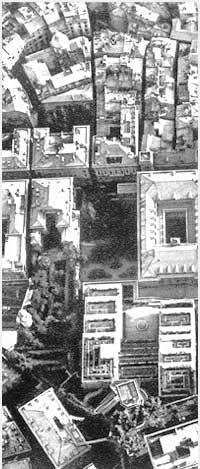The ancient 'Strada Nuova dei Palazzi' was created out of the desire of the aristocratic families in Genoa to build an outstanding district all of their own, a project born halfway through the sixteenth century. In the original project the present Via Garibaldi had the role of linking the two different parts of the city, that is to say it was to become the axis road joining the 'suburb' and the central zone. Strada Nuova immediately became the new aristocratic quarter as here, the wealthy families, found the space to build as they wanted to celebrate their own magnificence.
The new road was laid down as straight line, then divided into lots, which were sold at three public auctions.
The road was created with the aim of improving a seriously degraded area of the mediaeval centre, where the brothel was located.
In 1558 the building of the first sumptuous residences was started.
The most ancient families of the city's aristocracy took part in this intervention, the Spinola family built four residences, two the Grimaldis, the Lomellino family and the Pallavicinis.
The plans for this new city artery were assigned to the State architect Bernardino Cantone, not only did he design the structure and the course of Strada Nuova, but he also supervised the building of each palazzo as they gradually grew, thus giving life and status to this new area.
The building yard in Strada Nuova came to be a place for architectural experimentation, giving the possibility for the most avant-garde architects to try the most innovative and up-to-date designs.
The traditionalists say that the famous Perugian architect, Galeazzo Alessi, gave advice for the new city project while he was working in Genoa, halfway through the century, on the building of the Basilica dell'Assunta at Carignano and also on the planning of the new dome for the San Lorenzo Cathedral.
Between 1558 and 1583 eleven residences were built in this area, followed by, in 1671, Palazzo Brignole Sale, where today the Palazzo Rosso Gallery can be found, in 1714, Palazzo Bianco and the staple of Torrette in 1716.
The Rolli Palaces
The Rolli buildings, which today can be visited both in Strada Nuova (Garibaldi street) and in the neighboring area, narrate a centuries-old tale of international relations and of the Genoese people's opening to the relationship with representatives of different countries and cultures.
The 'Rolli Palaces' are a group of approximately 130 buildings of high architectural value used by the Republic as accommodations for high-ranking guests, such as kings, queens, dignitaries and rulers from all over the world, during their visits to Genoa.
The hospitality was rich and lavish, almost always tied by double thread to important and sensitive political, diplomatic and commercial interests, and had one distinguishing feature: it was born out of an agreement between public and private according to which the interests of the community were interpreted, a community engaged in consolidating old alliances and developing new ones.
The definition of the word rolli comes from the name of the lists of dwellings used for public purposes, in which the buildings were catalogued after having ascertained their "suitability" to host important guests. Someone has defined this system of palaces a sort of Republican Royal Palace. In fact, for a city that was potentially republican, this was the most successful way to deal with the problem of high-ranking guests.
The residences were subdivided into several categories, according to size, beauty and importance. For each group there was a sort of "dice-box" intended to hold slips of paper with the name of the owners, which were then drawn to see who would be assigned to a specific building. Aside from the major palaces, like the one that housed Prince Andrea Doria or the current Palazzo Reale, which were deemed suitable for accommodating even kings and queens, a list dated 1599 includes 127 buildings subdivided into three different categories:
- cardinals, princes and viceroys;
- feudal overlords and governors;
- ambassadors.
One of the scholars of the 'rolli', Ennio Poleggi, underlined the aspects that make them one-of-a-kind in the world: in addition to being an example of Renaissance urban culture, which has virtually disappeared everywhere else, they also represent a historical continuity, a sort of connection between the medieval culture and the Renaissance. Moreover, the system of palaces has not been damaged through the centuries and it has resisted even modern urban changes.


Aerial view: detail of Strada Nuova with its network of Palaces.(Picture taken from the book "Genova, Strada Nuova").
